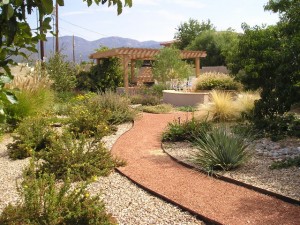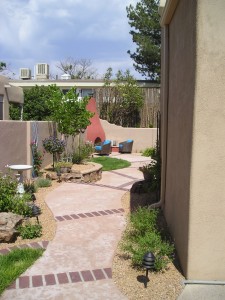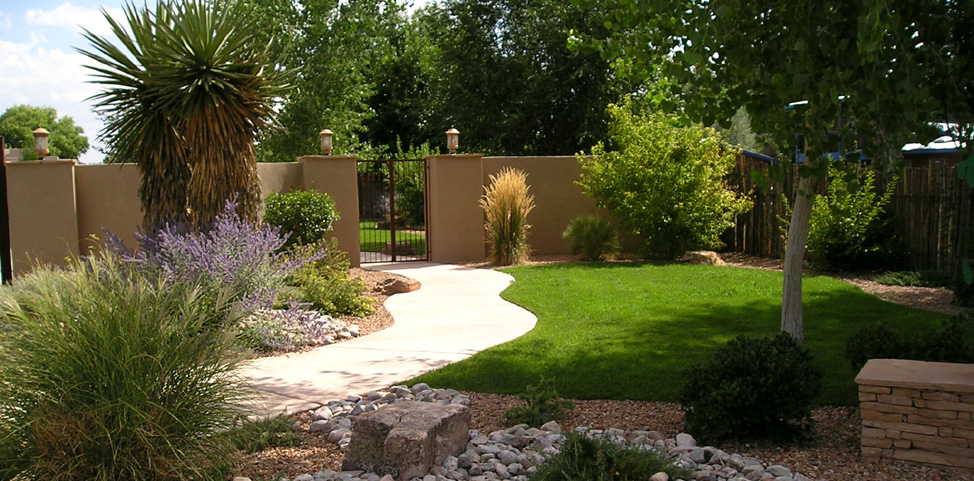Backyard Pathfinder
By Rick Nathanson, Journal Staff Writer, Albuquerque Journal
 A great lover of the simple pleasures of nature, 19th-century poet and philosopher Henry David Thoreau advised people to “pursue some path, however narrow and crooked, in which you can walk with love and reverence.”
A great lover of the simple pleasures of nature, 19th-century poet and philosopher Henry David Thoreau advised people to “pursue some path, however narrow and crooked, in which you can walk with love and reverence.”
Most people will be unable to re-create Walden Pond in their yards, but they can at the very least install some type of footpath, however “narrow and crooked,” to draw them outside for short walks and opportunities to smell the roses — or lavender, alyssum or sage — whatever might be planted there.
There are a number of practical and aesthetic reasons for building a footpath, say landscape designer Cheryl Thompson, of Cheryl’s Landscaping on Wheels, and landscape architect Amy Steidlmayer, of Red Twig Studio. Paths make walking easier and safer for people with mobility issues, they provide ready access for yard maintenance, and they physically and visually separate large, homogenous spaces, creating more interest and planting opportunities.
More abstractly, paths represent the possibilities of a journey to someplace known or unknown, so the more nonlinear the path is and the more obscured its end point, the more interest it holds.
“Pathways can pull people out to a different space or different part of the yard,” Thompson says. “It could lead to a guest house, a sitting or entertaining space, a secret garden, a shaded area or a water feature.”
Even in a small yard, says Steidlmayer, “large plantings can be used to create screens so the path has more allure and it’s not so obvious where it is going.”
MAKINGS OF A PATH
Both landscape professionals say the first thing
homeowners must do is come up with a design that addresses basic questions: How will the yard be used? Is there a need for separate spaces for children to play, animals to run, cooking and entertaining? What are the privacy and shade needs? Regardless if the yard is bare and awaiting planting or if it already has many of the landscape elements desired, the next thing to decide is how to best link these elements with a path, and what kind of path you want. The most common choices include sand, crusher fines, pea gravel, stepping stones, interlocking pavers and flagstone.
First, outline the path with a garden hose or with spray paint before beginning excavation. Regardless of the type of material to be used in the path, dig down a minimum of three inches. Be mindful of where and how water drains through the yard and try to avoid routing the path through areas where water pools.
If a clean line is desired to separate the path from abutting ground materials, this is the time to hammer in steel landscape edging, which Thompson and Steidlmayer prefer to plastic edging. Steel edging is four inches wide so it will have to be dug in a bit so that the top of the edging is even with or just barely above the top of the path. If too much edging protrudes it can be an obstacle to walkers.
Steel landscape edging comes in 8-foot lengths and retails for about $10. Brick edging is also available. It varies in price from 70 cents to $2.25 for 12- to 18-inch lengths that are from 3 3/4 inches to 5 inches tall.
This is also the stage to put down weed fabric if desired. Three inches of fill material by itself is often enough to impede the growth of most weeds into the path. As extra insurance, weed fabric can be laid down and pinned firmly into place with specially designed “staples.” Weed fabric is a woven material that allows water and air to percolate into the soil, but prevents weeds from growing through. Impermeable black landscape fabric should never be used because it traps water and heat, doesn’t accommodate air flow and has a tendency to work its way to the surface over time, says Thompson.
General purpose landscape fabric costs about $10 for a 3-foot by 50-foot roll. A package of landscape fabric pins also costs about $10.
GETTING EVEN
A one-inch base course of sand should be put down if the medium for the path is stepping stones, pavers or flagstone. That allows some “wiggle room” so variations in thickness of the stones can be equalized by working the stones into the sand so the tops are all level. This is especially important with flagstone, which can have a noticeable difference in thickness from piece to piece. Likewise, sand can be added beneath particularly thin portions of a piece of flagstone to raise it or add additional support.
Stepping stones and pavers are available in a variety of colors and sizes, and depending on where they are purchased can range in price from 50 cents to $9 each. Flagstone can also be quite pricey. Depending on the thickness, color, general quality and shipping distance from quarry to retailer, expect to pay $450 to $700 for a 2-ton pallet.
Once the stones are in place, the surrounding pathway areas can be filled in with sand, crusher fine, three-quarter-inch “pea” gravel or mulch.
When the medium is solely crusher fine, Thompson and Steidlmayer recommend adding one inch at a time, wetting it down and compacting it with a sod roller, then repeating the process until the path is filled to the desired height.
They don’t recommend using a sod roller to compact a path that contains stepping stones, pavers or flagstone. The weight of the roller can cause them to pop out or crack.
Be aware, cautions Thompson, that organic mulches like bark or pecan shells tend to be lighter in weight and can get scattered with a strong wind. Shredded rubber mulches are heavier but also more expensive.
In general, organic mulches and a limited number of rock and gravel mulches are available from home improvement stores and nurseries in individual bags containing 1- to -5 cubic feet of material. For smaller garden path projects, that may be sufficient. For larger projects requiring greater amounts of material, it will likely be more economical to purchase from local stone and landscape outlets that sell mulches and gravels by the cubic yard.
Originally published Saturday, October 03, 2009
READ OUR OTHER FEATURED ARTICLE IN THE ALBUQUERQUE JOURNAL

